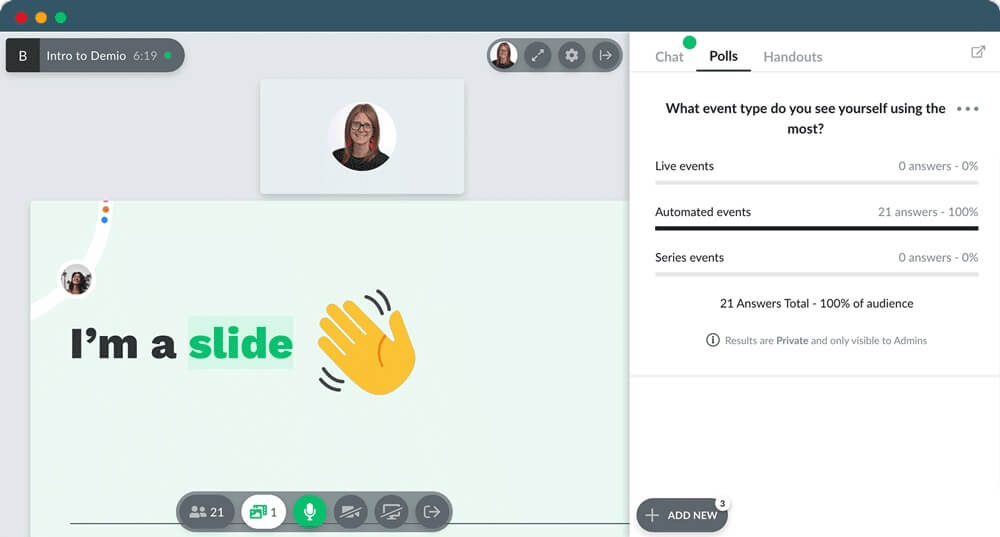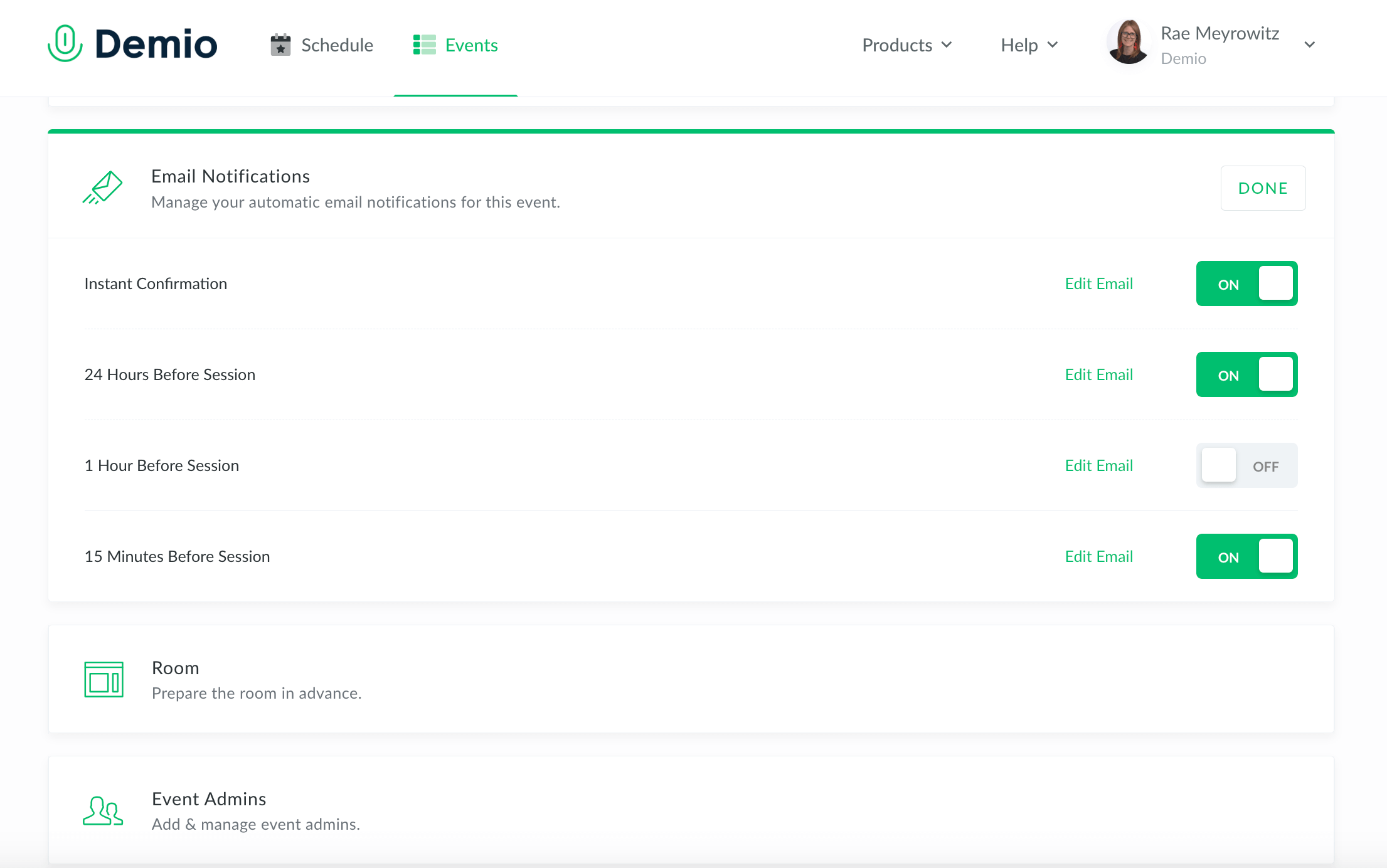How to Prepare a Product Demo: Checklist for Flawless Presentations
You don’t need to be a perfect salesperson to deliver a great product demonstration. Expertise, research, planning, and practice can prove far more useful than excellent presentation skills. (Of course, those skills don’t hurt either.)
With a comprehensive plan, you can make a great product demo with anyone and for any organization. The following product demo checklist will walk you through everything you need to build a great demo.

Understand Your Audience
The foundation of any successful virtual event is understanding your audience. That necessitates in-depth research into your target market to learn who your product serves, the struggles they face, and topics of interest to them so you can tailor your product demo accordingly. You can employ a few tactics to uncover this critical information.
Research Prospects
- Most product demos possess basic requirements similar to those of job interviews. The companies and people you present to expect you to understand their needs, specific pain points, and how your product can accommodate both.
Your product can have any number of excellent features and great functionality. But you need to match the solutions it offers with the prospect’s unique needs to build the groundwork for a successful product demo.
Focus on pain points and the step-by-step explanation of how your offering can fix them.
Read more: Solutions for sales teams
Screen in Advance
Email marketing before the demo is crucial for ensuring a high attendance rate. But it’s also an opportunity for research. Take advantage of this time to ask your event registrants about:
- Their backgrounds
- Their current roles
- Their most important pain points
- What tools they currently use
Then, use that information to mold your demo experience and wow your attendees.
After a succession of happy clients, you can also feature case studies. If you already have the information you need, start fine-tuning your product demo script. Client success stories should be engaging and present the story through the eyes of customers whom your attendees can relate to.
Polls
Capitalize on built-in virtual event features like polls or post-event surveys to collect honest opinions from attendees about where your demo excelled and where it fell short.

Define Your Objectives
Key performance indicators (KPIs) measure the success of a product demonstration but you also need to monitor other metrics to determine how well your demos align with customers’ goals and needs.
KPIs
KPIs are important benchmarks for decision-makers, and you should design each demo to reach them.
The most important KPIs are conversion rate and profits. You need to gain qualified leads and transform them into customers as well as ensure your expenses don’t exceed your revenues.
Additionally, there are many more KPIs to set for the product demo experience, like engagement metrics. An interactive demonstration will have a greater impact on those attending than a passive one.
Need a starting point? Check out Demio’s built-in engagement metrics for its engagement features.
Other Success Metrics
The other part of the equation is tailoring the demo environment to the audience. This requires researching your target segment (like we discussed earlier). However, virtual event platforms and their email marketing integrations enable you to collect post-demo data to craft better experiences with ease.
Q&A sessions and post-event surveys included in your virtual event software are the primary methods of gathering this information. Ask general questions about attendees’ interests as well as satisfaction scores and other quantifiable feedback.
Prepare Your Agenda
Background research and defined objectives are the foundation of a winning agenda.
Product Demo Structure & Script
Craft an engaging narrative that highlights your product value and functionality. Use that narrative to build your script with the following structure:
1) Hook
Start with a compelling and relatable hook in the introduction. This is the moment you capture your audience’s attention and hint at the value proposition you’re offering.
Incorporate elements of storytelling element. Focus the hook on a real-life problem your company and product can solve.
2) Context & Background
Briefly introduce your team members, company, and background. Then, move into a short description of the product and tie it to your hook.
Provide testimonials and statistics that highlight your product’s value. You can connect it to industry trends and statistics, if relevant; the goal is to show your audience how your product is valuable.
3) Features & Functionality
Next, highlight your product’s most important features. Stay laser-focused on solving customer problems and thus alleviating their pain points. Explain how those features benefit the user’s workflow and resolve their most pressing challenges.

4) Integrations (if any)
Show off how your product can integrate (if applicable) with other products, tools, and software solutions. Emphasize any particularly effective partnerships or how your product can otherwise cooperate with other products for enhanced effectiveness.
5) Use Cases
Case studies, testimonials, and other “before and after” presentations that show your product in use are powerful social proof. Capitalize on this opportunity to emphasize the substantive benefits your product offers. Importantly, hone in on the “before and after” aspect so the benefits are clear.
6) Objection Handling
Draw on past experiences and audience research to anticipate and prepare for the common objections your attendees may have. Leave time at the end of the event for a Q&A session as well so you can answer any specific concerns.
7) Demonstrate Use
After providing case studies that tell your audience your product’s worth, show them by putting your offering to use. Take your time in this segment to ensure attendees clearly understand how it operates. This is also a prime time to highlight its ease of use or user-friendliness.

Running the Demo
Throughout the demo, there are a few elements you should incorporate.
Simple Language
When drafting your script and rehearsing for the Q&A, remember to keep things simple. Some product demos may have a larger proportion of more experienced audience members, but it’s better to err on the side of caution and ensure your presentation is easily digestible to as broad of an audience as possible.
Explain how the product works in simple language that’s engaging and revolves around solving problems.
Interactive Features
Insert interactive elements often. Virtual event platforms normally offer a variety of engagement features to encourage participation among audience members and hold their interest. Demio specifically possesses engagement features like surveys, Q&A sessions, featured actions, and more for a memorable and unique experience. These opportunities introduce fun into your event and keep audience members invested in the experience.

Prepare Slides
Slide decks take time to build and need to be done well to yield results. However, they can highlight product features and structure your presentation so the speaker can manage its progression more easily.
Introduction slides acquaint attendees with your company and presenters, as well as set expectations for the event. After that, simple but well-designed company slides serve to highlight key information that audience members should know.
Meanwhile, product overview slides are the meat of the deck. Include a high-quality photo, name, and logo, but keep the text to a minimum; include two to four of the most important benefits in large text so they’re easy to grasp. Refer to them throughout the script as well to drive home their value.
Conclusion slides are the last of the crucial deck additions. You need one of these to summarize the experience, outline next steps, and share your company’s contact information.
Ensuring all Demo Materials Are Ready
After you’ve crafted an agenda and prepared your materials, it’s time for final checks before the formal presentation. At this point, you have a few simple but important choices to make.
Reliable Platforms
The right virtual event platform simplifies the creation of a stellar product demo, so choose carefully. Additionally, they possess different interfaces, levels of complexity, features, and integrations with other marketing tools like CRMs and email marketing. Those elements contribute to a memorable attendee experience from registration through post-event follow-up.
Demio’s platform focuses on engagement and easy-to-use interfaces that are simple to navigate. You also gain access to a wealth of features that provide everything you need for an incredible online session without overwhelming your staff. Everything is centered around the analytics and reports you receive, which give you a thorough understanding of your product demo’s success.
Supporting Materials
In addition to the main presentation and slides, handing out supporting material is now standard practice for virtual events. If you want to impress your demo attendees, prepare high-quality digital handouts that provide additional value for audience members.
Rehearsing the Product Demo
Rehearsing the product demo is crucial for troubleshooting and ensuring everyone is prepared for the live launch. If any issues arise, you can rehearse again to remove the kinks and maximize the chances of a successful demonstration.
All staff and stakeholders should be present for rehearsals. Technical issues, unclear speech, or delivery problems can ruin a live presentation, so make sure to identify and resolve these challenges durings rehearsal. If possible, throw random questions at presenters from your knowledgeable staff members to simulate possible scenarios during the real demo.
Record every dress rehearsal as well so everyone involved can review each step carefully.
Moderation
Moderators oversee product demo time frames and audience interactions, curating attendee inquiries and ensuring everything goes smoothly. So, take the opportunity during rehearsal to troubleshoot issues that could plague the moderators during the real demo.
Confirm the Date and Time
People have busy lives, and your demo won’t always be a top priority. That’s why confirmation is so important; it reminds as many people as possible about the event so they attend, leading to large audiences.
Confirmation Emails
Built-in or integrated email marketing connects registrants to the event. It thus ensures a higher number of them attend your demo. Upon signing up, registrants should receive one email with all the event details.
After that, take advantage of email marketing to send reminders at specified intervals prior to the demo.
With Demio, you can create customizable experiences with automated and branded email reminders. Easily edit your communications and toggle automation on and off to maximize your attendance rate.
Registration follow-up emails promote event readiness and help maintain people’s interest. So, build anticipation with sneak peeks and teasers that keep your event in their heads.

Ask Questions in Advance
Product demos are meant to be interactive, so, why not start before the event?
Use email follow-up to find out more about your demo’s prospective attendees. Ask them what they’re most interested in and problems take top priority. Show them you care and that this event is about them, not your product. This thoroughness ensures the demo covers important ground.
Retrospection and Improvement
Retrospection and improvement are about analysis and readjustment. Here’s how it works.
Feedback
First, collect satisfaction feedback from attendees after every product demo. Ask them questions that they can answer on a rating scale of 1 to 10, such as:
- How satisfied were you with this product demonstration?
- How likely are you to use our product or recommend it to a colleague/friend?
- How much value would you say you gained after joining our product demonstration?
Analysis & Alterations
In addition to these surveys, you’ll also have to sift through a lot of statistical data. Remember the metrics and KPIs you set earlier? Now’s the time to review them. These metrics gauge your demo’s performance against past and future events. Use them to set new benchmarks and refine successive demos for stronger results.
Smash Your Next Product Demo
With the right checklist guiding your efforts, you can consistently organize and execute fruitful product demos. Although it takes time and attention to detail to craft a memorable event, the elements we’ve outlined in this article will help smooth your path forward.
To simplify the creation process, look for a robust virtual event platform. With included features like automated event reminders, interactive elements, and communication templates, the right platform can remove much of the headache of building a product demo.
Get started for free with Demio and showcase your products on a professional, reliable platform.

Frequently Asked Questions About a Product Demo Checklist
What are the stages of a product demo?
A product demo includes the following segments:
- Introduction
- Event outline
- Statement of the problem
- Introduction of the product
- Features and benefits
- Case studies and testimonials
- Live demonstration
- Q&A
- Pricing and plans
- Next steps
- Closing remarks
- Follow-up
What Should I not do during a product demo?
A few mistakes that many product demo organizers make (and that you should avoid) include:
- Neglecting audience research
- Information overload (focus on a few key solutions)
- Lack of rehearsal
- Not focusing on value
- Being too “salesy” (hone in on problems and solutions; don’t push)
- Poor technical quality
- Ignoring engagement opportunities
How do you start a product demo?
Start your product demo with a strong and energetic introduction of yourself and the brand you represent and welcome the audience. Go over the agenda and set clear expectations right away so people don’t get antsy.
Related Articles
.webp)
Mastering Product Demo Videos: The Ultimate Guide
%20(1).webp)
.svg)